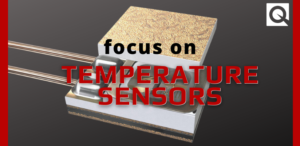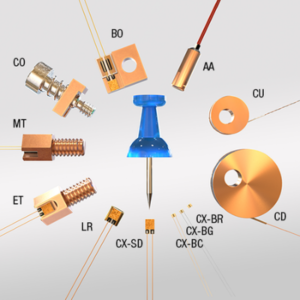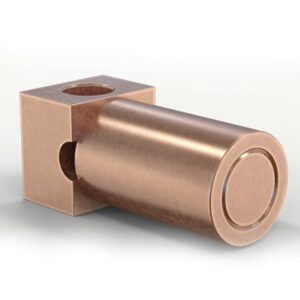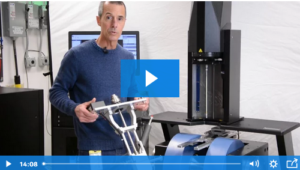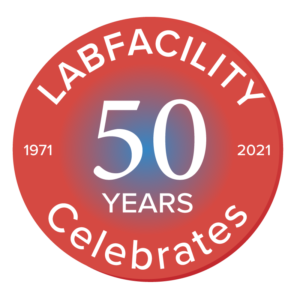 Sensor Technology has launched a new range of non-contact torque sensors based on a full four element strain gauge bridge design, complementing its existing non-contact sensors that use surface acoustic wave (SAW) detection.
Sensor Technology has launched a new range of non-contact torque sensors based on a full four element strain gauge bridge design, complementing its existing non-contact sensors that use surface acoustic wave (SAW) detection.
Designated the TorqSense SGR510/520 series, the new units have a 250% overrange reading capacity, allowing sudden spikes in torque to be measured and recorded accurately. The design also compensates for any extraneous forces, such as bending moments, inadvertently applied to the sensor, improves sensitivity and has a wide temperature tolerance.
The bridge is essentially four strain gauges glued onto the shaft that is to be monitored in a square formation set at 45deg to the axis of rotation. Thus, when torque is applied to the shaft two gauges are stretched into tension and two go into compression.
A rotor mounted ultra-miniature microcontroller, powered by an inductive coil, measures the differential values in each strain gauge and transmits them back to the stator digitally, via the same coil. The SGR510/520 series transducers then use state of the art strain gauge signal conditioning techniques to provide a high bandwidth, low cost torque measuring solution with high overrange and overload capabilities.

“This design gives the TorqSense SGR510/520 several significant advantages over conventional torque sensors,” says Mark Ingham of Sensor Technology. “Firstly, it eliminates the sort of noise pickup and signal corruption associated with slip ring and other analogue methods of transferring torque data from rotor to stator.”
Mark explains that external noise pickup into the wiring is virtually eliminated due to the short distance between the strain gauge elements and the rotor’s measuring circuits. Further, multipoint calibration reduces any linearity errors within the sensor.
He goes on to say that the large functional overrange capability allows the peaks of a torque signal to be captured faithfully without any clipping when operating the sensor close to its full-scale rating. This, combined with a mechanical overload capability of over 400%, make the SGR510/520 series torque sensor a very robust torque measuring solution.
 The measuring range of the SGR series is 1Nm to 500Nm (with models up to 13000Nm available shortly), accurate to +/-0.1% and with a resolution to +/-0.01% of the transducer’s full scale The digital transmission between rotor and stator cuts out all cyclic fluctuation of the signal due to shaft rotation and generates a digital sample rate of 4000 samples per second.
The measuring range of the SGR series is 1Nm to 500Nm (with models up to 13000Nm available shortly), accurate to +/-0.1% and with a resolution to +/-0.01% of the transducer’s full scale The digital transmission between rotor and stator cuts out all cyclic fluctuation of the signal due to shaft rotation and generates a digital sample rate of 4000 samples per second.
Other features include an optional adjustable moving average filter, power supply range from 12VDC to 32VDC, user configurable analogue output voltages, a choice of RS232 communications, USB interface, CAN bus interface, external Ethernet gateway, and LabView virtual instruments.
“For ease of use there is a built-in test function,” says Mark, who summarises the new TorqSense SGR510/520 with: “Most torque sensors require the use of slip rings to transfer torque readings from the rotating shaft to the static readout. These are noisy in use, slow and fiddly to set up and, as wearing parts, are not always reliable.
“Our TorqSense ranges operate without slip rings, using non-contact signal transfer instead, so these problems are designed out at a fundamental level. The new SGR510/520 series will be suitable for torque measuring, testing, feedback control of drive mechanisms and process control applications.

What are the main advantages of the new SGR sensors?
Greater immunity to bending effects, and a fully functional over-range reading capability up to 250% of the transducer’s rated torque.
Will you be maintaining the SAW product range?
Our SAW products already in the field have lifetime guarantees, which we will continue to support. The new SGR range is designed to meet almost all technical needs, so we expect its to become a popular first choice
Is accuracy an issue when measuring torque, which can vary by the second?
The best accuracy class for SAW sensors is +/-0.25%, but with full bridge strain gauge and microcontroller we can achieve accuracy of +/-0.1%. This meets the needs of most current industrial applications, and indeed for most test and research applications. The new SGRs will be even more accurate, making them suitable for the most demanding applications and enabling test engineers to take their findings to the next level, thus improving the state of the art
How do they compare on price?
We will be marketing the new range at the same price as our existing products
What sectors do you expect to be keenest on the new products?
R&D and Quality Assurance applications will benefit from the improved accuracy, so we will probably see them most excited. Some of the industrial data capture applications are also keen to improve accuracy. We expect that over the next few years most applications will come to expect greater accuracy
 Hydro International launches its new monitoring and telemetry logger to help engineers to monitor and collect even more data for water flow, level, quality and weather in remote locations or where there is no power supply.
Hydro International launches its new monitoring and telemetry logger to help engineers to monitor and collect even more data for water flow, level, quality and weather in remote locations or where there is no power supply. The new logger offers improved user interface, including protected Wi-Fi access, allowing engineers to configure the FL105 logger. Where available, the Wi-Fi can be used to transfer data to Timeview® or to your own server via FTP. Its new design keeps wiring and components isolated so that the battery or SIM card can be switched out safely.
The new logger offers improved user interface, including protected Wi-Fi access, allowing engineers to configure the FL105 logger. Where available, the Wi-Fi can be used to transfer data to Timeview® or to your own server via FTP. Its new design keeps wiring and components isolated so that the battery or SIM card can be switched out safely. Instrumentation Monthly Test | Measurement | Control
Instrumentation Monthly Test | Measurement | Control





